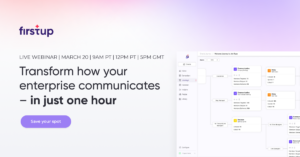Yesterday I was fortunate enough to be joined by Louisa Moreton, Partner and Head of Finsbury’s Employee and Change Communications practice, Erica Cary, Sr Director of Digital Product Management at Hilton, for our webinar on ‘how personalisation can deliver gains for business and culture’. The aim of this joint series with our friends and global advisory firm, Finsbury, has been to focus on how organizations can explore new behaviors as we continue to adapt to the pandemic and its impact upon traditional working practices.
Same sea, different ships
With decades of employee experiences between the three of us we set out to explore what we’ve learned over the last six months and to share any gems from our experiences so far. As Louisa highlighted Covid-19 is impacting us all, every company and every individual but all differently. CEOs have had to step up and become Chief Engagement Officers. They’re more visible than they’ve ever been and, on the whole, they have become more personal, delivering messages to their workforce via webcasts, blogs and videos to name a few.
There is no doubt that this behaviour has helped many during a time of turbulence and anxiety. However, we asked how long is this sustainable? The constant adapting to changing Government guidelines alone is exhausting. For example, in the UK businesses were being pushed to encourage workers back to the office, only to have a Government U-turn earlier this week requesting that all those that can should work from home again. I am sure we will continue to see similar behaviour all over the world as the virus ebbs and flows. We all agreed that trying to remain agile for such a long time is utterly exhausting. However, all is not lost, and there are a lot of positives to take from this experience. We are continuing to learn and while it’s daunting businesses and brands are continuing to raise the bar.
Appealing to hearts and minds
Business leaders have to strike a balance of growth and recovery alongside cutbacks. It’s risky because middle or line managers can feel disenfranchised with the business as they try to keep up with what will happen next but aren’t always involved in those crucial conversations. Furthermore, as Louisa highlighted, it feels incredibly disingenuous to be delivering a recovery narrative that also encompasses redundancies, reduction in investment and many other cuts.
Yet, as Erica’s efforts at Hilton show, it may be challenging adapting to a reduced workforce, handling furloughs and extending furlough schemes remotely across a global business but out of this unprecedented event a whole new capability around digital wellness has been born.
Five years of digital transformation in five months
Having assessed different solutions in the market Hilton opted to leverage its existing internal products and solutions to build their own digital wellness platform. “We utilize Firstup for the front end-user experience. It’s the front door to our platform which consists of daily wellness surveys, contact tracing solutions along with enterprise dashboards, reporting and analytics,” Erica explained.
Louisa highlighted that while many businesses have a watertight strategy and focus to survive, they also need to acknowledge the hearts and minds of their staff just like Hilton. “It’s hard to accept but logic just isn’t enough. Remember anxiety levels are through the roof and as a result we aren’t necessarily consuming facts and data rationally. As a result, leaders need to over-communicate to their people and continually ask the question ‘what’s in it for me?’ from their employees’ perspective.”
Embrace empathy
So, if there’s one lesson from our discussion it’s that empathy is an absolute must. You need to lead with care. Like so many organizations Hilton has had to make redundancies but has partnered with other companies around the globe that are recruiting. This Hilton Alumni is a talent pool for those seeking full or part-time positions or contract employment and currently represents over one million job opportunities.
We all agreed that the businesses that understand and demonstrate emotional intelligence will be the ones that recover faster. Traditionally there has been an under-investment in internal communications, but those barriers are falling as IC directors sit at the right hand of the CEO. As Louisa commented, “When things eventually return to an even keel, we must not let anyone forget that high engagement didn’t happen by chance.”
In addition to empathy we discussed three other key behaviors that businesses need to adopt as the pandemic continues to impact our lives – diversity, transparent communications and leadership. And it’s important to note that when, one day, things do return to normal these behaviors should not be allowed to slip down the list of priorities. Covid-19 has been an accelerant for digital transformation but it has also presented companies with the exciting opportunity to break down barriers and rapidly evolve.
Agile diversity
The reality is that the world has changed, and it will continue to do so. We need to adapt quickly to these new and diverse requirements. While some in the UK experienced a brief break from remote working, businesses struggled with the hybrid approach as Louisa described, “Being part office and part online is a huge challenge. Firstly, the technology in most businesses doesn’t facilitate a great hybrid meeting with some present and others on camera. Furthermore, we tend to default the balance of power to those being in a physical room which creates problems around inclusion.”
If people start to feel isolated from their teams then your business faces a risk of disenfranchised employees. It’s a challenge that we all face and one that leaders, HR and comms need to address so that opportunities open up to people, no matter their location, working pattern, personal commitments or physical restrictions. If we can strike the right balance, then suddenly a world of opportunity opens up to our workforces.
Transparent communications
Erica discussed how clear, concise and transparent communications are absolutely paramount. And described how Hilton took the opportunity to consolidate and streamline communications down from seven to two enterprise communications channels which helped to make it very clear where people needed to go for information, news and resources.
To leverage this further Erica created COPE – CREATE content in ONE place and PUBLISH EVERYWHERE. People don’t have the time to trawl different feeds to check on information and communications no longer has the time to create different versions of the same message. If you focus on making your communications dynamic and engaging, you’ll reach and resonate with your workforce while driving greater efficiencies.
Leadership
While the majority of today’s business leaders never envisaged having to face the fall out of a pandemic we are here and there’s still much to be done. Winter is fast approaching and as people face the news of further restrictions, colder weather, less sunlight and infection rates on the rise it is our leaders who need to lead by example. Trust and authenticity have never been more important, and they will need to lean into and spearhead discussions around mental wellness, be empathetic and celebrate the successes along the way.
Closing thoughts
As with our previous webinar on ‘Prospering in the Digital Workplace; Insights from Behavioural and Neurological Science’ it’s also important that businesses continue to connect with their people – burnout is a very real concern. Our needs are constantly evolving so carrying out a regular pulse survey to understand, listen and act accordingly is critical. Furthermore, businesses need to continue to adapt and set new working limits. We said at the beginning of this blog that the pace we set at the beginning of the crisis is not sustainable and as such leaders need to introduce a number of practical steps to help their workforce. Encourage people to limit their time for online meetings, reduce the number of daily priorities, ideally to three, and allow an hour to decompress, away from their home desks as they would have done on their daily commutes or lunch breaks. Those natural interruptions no longer exist so we need to introduce new behaviors and the most likely way they’ll succeed is if they’re mandated from the very top of your organization.
And finally, we all need to remember that just because certain practices worked earlier this year it doesn’t mean they will continue to. Both Erica and Louisa urged our listeners not to just assume everything is working and that we should continue to test, learn, repeat, refine and adapt. Not everything will be perfect, not everything is sustainable so embrace your newfound agility to create and maintain an ever more present and better way of working for all.












